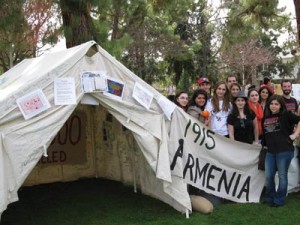Denise Altounian
Staff Writer

Photo: Barlow Der Mugrdechian
Almost every Armenian grows up learning about the Armenian Genocide. We are told of the massacres our ancestors faced at the hands of the Young Turks, and the struggle we now face to keep this story alive, in hopes that one day it will get the recognition it deserves. Many times this is done in vain, as we come to learn that all too many of our peers have never even heard of the Armenian Genocide. However, how many of us are aware of similar atrocities that have taken place in Bosnia, Cambodia, Rwanda, and Sudan?
On Monday, March 5, Fresno State sought to change this as the traveling exhibit, “Camp Darfur,” was brought to campus. “Camp Darfur” is a traveling, simulated refugee camp, meant to educate the public about the current genocide happening in Darfur, Sudan, while reminding them of genocides of the past.
The event was held in the Memorial Gardens, in front of the Kennel Bookstore, and was open to students, faculty, staff, and the community. The Holocaust and the genocides of Armenia, Cambodia, Bosnia, Rwanda, and Darfur were each represented by an authentic U.N. refugee tent that was filled with information, pictures, timelines, and articles.
This event was brought to campus by USU Productions, Fresno State’s student programming board and i-Act, a nonprofit organization, whose aim is to bring awareness to violations of human rights around the world. Also featured were speakers at a noon program that included a survivor of the Bosnian Genocide, a daughter of Cambodian Genocide survivors, and Dr. Matthew Jendian, chair of the Sociology department at Fresno State and the grandson of three Armenian Genocide survivors.
The Armenian Students Organization helped add to the event by hosting a table, bringing the replica of the Armenian Martyrs Monument (Tsitsernakaberd) and having the public make colorful paper carnations to place on the monument. The students were able to add their knowledge to the event and ensured that the public left knowing that there was a Genocide of the Armenian people in 1915.
Camp Darfur was a great success as many people walked through the exhibit and were able to learn that genocide is both a problem of the past and of today.
 Hye Sharzhoom Armenian Action
Hye Sharzhoom Armenian Action